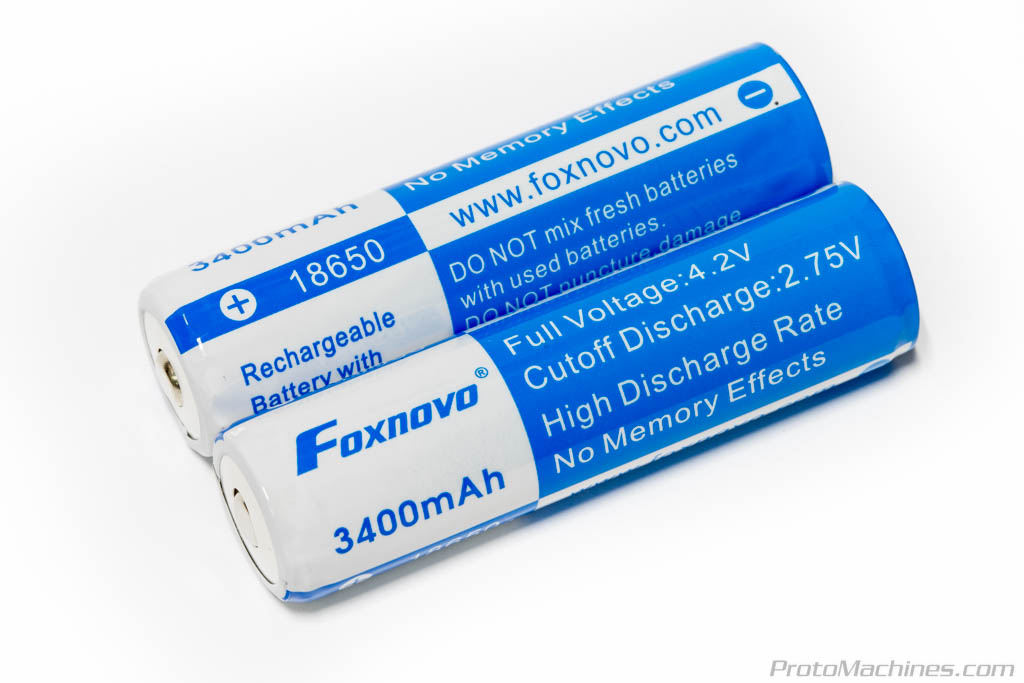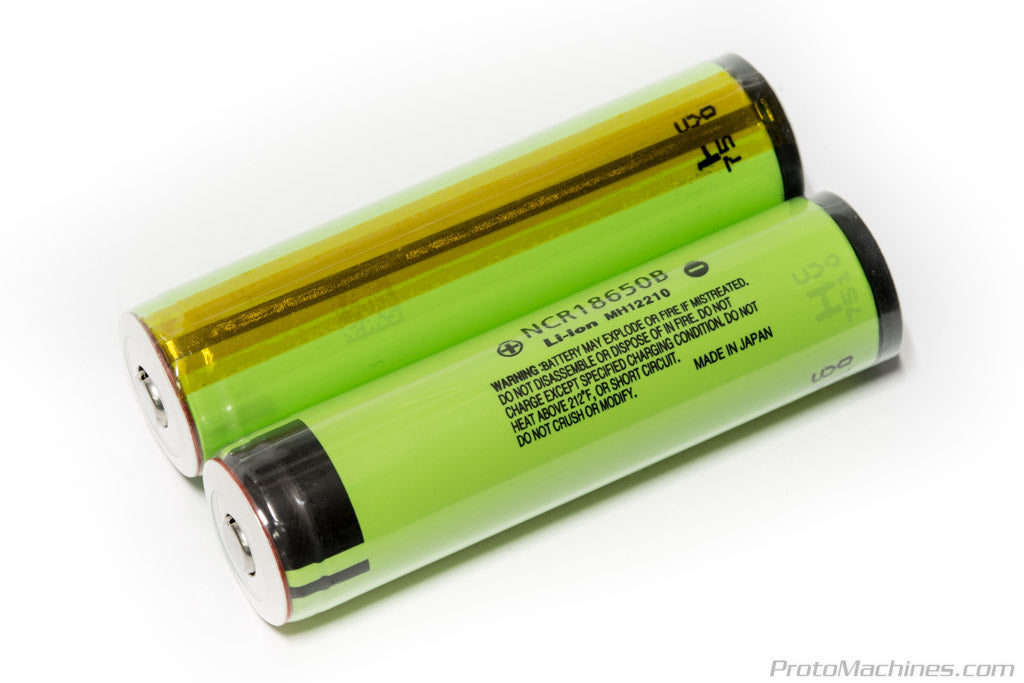18650 Battery FAQ
As with all high-powered batteries, basic safety precautions should always be followed to reduce the risk of fire, electric shock or personal injury.
In order to help our customers narrow down what cells to use, we have compiled a list of measurements below. Please bear in mind that the measurements are based on a limited number of test cells at the time, and that battery manufacturers may change their suppliers and specifications at any time. If you are unsure if a particular cell will fit or discover our measurements are out of date, please contact our tech support department for assistance.
Please DO NOT use metal tools when measuring batteries. A short circuit could result in damage to the battery, fire or bodily injury.
Most PCB protected cells usually have a metal band running the length of the cell, and are slightly longer on one side. Take multiple measurements at different points around the circumference and use the largest value.

LED2 / LED8 - The LED2 and LED8 may be used with either flat-top or button-top PCB protected 18650 li-ion cells up to 18.8mm diameter x 69mm overall length, and 68mm max body length. If the door is difficult to close or the latch does not snap back into locking position, the cells are probably the wrong size. DO NOT use excessive force! The battery door should require less than 4.5lb/2kg of force to close.
RADIUM - The RADIUM LED may be used with button-top PCB protected 18650 cells up to 19mm diameter x 70mm overall length. The button should protrude at least 0.5mm to maintain proper electrical contact. If the cell has a button shorter than 0.5mm, the product may lose power or reset randomly. If this happens try a cell with a more pronounced button, or rotate the cells until the edge with the metal band is facing the battery door.
- Do not allow the battery terminals to come into contact with metal objects. This can lead to a possible short circuit or fire.
- Do not subject the battery to strong impacts or shock. If the battery (or device) is dropped onto a hard surface, promptly remove batteries to a fire resistant location and inspect for damage.
- Always inspect a cell's insulation wrap for damage before use. Minor nicks or tears may be repaired with electrical tape. Discontinue use if significant damage or dents are found.
- Do not expose to extreme heat or flame. Do not dispose of in fire.
- Do not allow cells to get wet or be submerged.
- Do not recharge cells in extreme cold or freezing conditions. Always allow cells to reach room temperature before recharging.
- When storing or transporting cells, use of a plastic carrying case to protect the terminals and to prevent them from rolling around is advised.
- Always observe all FAA and airline safety guidelines when transporting li-ion batteries by airplane.
- Do not dispose of li-ion batteries in the trash. Always tape over the positive terminals before depositing them at an approved battery recycling center.
What are 18650 li-ion cells?
18650 li-ion cells are cylindrical rechargeable cells, shaped like giant AA alkaline batteries. They have a higher nominal discharge voltage of 3.7V, which gives them a signifcant power advantage over the older alkaline(1.5V) and nimh/nicad(1.2V) chemistries. 18650 li-ion cells can be found in laptops, power tool battery packs, electric cars and countless consumer goods.Why are they called 18650?
The term 18650 comes from the IEC naming scheme for round cells based on their physical dimensions. The first two digits are its diameter in millimeters, while the last 3 digits are for its height in 1/10th millimeters. Based on this naming convention, the original 18650 cells would be 18mm in diameter x 65.0mm in length.What does PCB protected mean?
Most modern raw lithium-ion cells contain passive safety features like PTC (pressure, temperature and current) protection, however the cells may still be damaged if they are over-charged or over-discharged. To reduce the risk of damage, battery manufacturers will add a tiny circuit board (PCB) to the bottom of the raw cell to monitor its voltage and disconnect power if it senses an error. The protection PCB usually adds 2-3mm to the length of the cell, and the small metal band connecting the PCB to the positive terminal will add a ~0.5mm bulge to its diameter.What is the difference between a button-top vs a flat-top cell?
Button top cells have a positive terminal that protrudes 1-2mm (ie, the "button"), similar to the positive terminal on AA batteries. The button allows the cells to be stacked in series in a flashlight or similar consumer device. In contrast the positive terminal on a flat-top cell does not protrude, and are intended to be tack-welded into a larger battery pack. If a flat-top cell is used in a device that only accepts button-top cells, the flat-top might not form a reliable electrical connection.Are 3400mAh cells worth the added cost over 2600mAh cells?
During our testing we found that 3400mAh cells performed best at low discharge rates (<0.2A), but their usable capacity dropped rapidly as the discharge rate was increased. With a 5A discharge rate, the 3400mAh cells performed roughly the same as the much cheaper 2600mAh cells. In our opinion the 3400mAh cells might be worth it if you stick to the lowest power setting only, but 2600mAh cells offer more bang for the buck in general.Is it OK to mix cells with different capacities or charge levels in the same device?
No, it is not safe to mix li-ion cells with different cell capacities or charge levels. Doing so may cause some cells to discharge below their lower safety limit and causing permanent cell damage. Always use cells of matching capacity and charge level.Will it fit?
As you may have already noticed, the 18650 specification has become more of a suggestion than a standard. The cell lengths seem to increase every year. Panasonic's popular NCR18650 raw cells are already larger than the specification, and the addition of a protection PCB virtually guarantees all cells will greatly exceed the original 18mm x 65mm specification. We have found that 1/3 of cell models exceed even their own manufacturer's size specifications, so their dimensions should be used only as a starting point.In order to help our customers narrow down what cells to use, we have compiled a list of measurements below. Please bear in mind that the measurements are based on a limited number of test cells at the time, and that battery manufacturers may change their suppliers and specifications at any time. If you are unsure if a particular cell will fit or discover our measurements are out of date, please contact our tech support department for assistance.
Please DO NOT use metal tools when measuring batteries. A short circuit could result in damage to the battery, fire or bodily injury.
Most PCB protected cells usually have a metal band running the length of the cell, and are slightly longer on one side. Take multiple measurements at different points around the circumference and use the largest value.

LED2 / LED8 - The LED2 and LED8 may be used with either flat-top or button-top PCB protected 18650 li-ion cells up to 18.8mm diameter x 69mm overall length, and 68mm max body length. If the door is difficult to close or the latch does not snap back into locking position, the cells are probably the wrong size. DO NOT use excessive force! The battery door should require less than 4.5lb/2kg of force to close.
RADIUM - The RADIUM LED may be used with button-top PCB protected 18650 cells up to 19mm diameter x 70mm overall length. The button should protrude at least 0.5mm to maintain proper electrical contact. If the cell has a button shorter than 0.5mm, the product may lose power or reset randomly. If this happens try a cell with a more pronounced button, or rotate the cells until the edge with the metal band is facing the battery door.
| Manufacturer | Model | Capacity (mAh) |
Voltage (V) |
PCB | Button Top |
Total Length |
Diameter | Body Length |
Date Tested |
LED2 | LED8 | RADIUM | |
|---|---|---|---|---|---|---|---|---|---|---|---|---|---|
 |
ATK | ATK-0943 | 3400 | 3.7 | YES | YES | 68.84 | 18.69 | 68.05 | 1/2018 | NO | NO | YES |
 |
EAGTAC | ET2600 | 2600 | 3.7 | YES | YES | 68.45 | 18.67 | 67.75 | 1/2018 | YES | YES | YES |
 |
EAGTAC | ET3400 | 3400 | 3.6 | YES | YES | 68.25 | 18.45 | 67.99 | 1/2018 | YES | YES | YES |
 |
Foxnovo | ICR18650 | 3400 | 3.6 | YES | YES | 69.52 | 18.89 | 68.84 | 1/2018 | NO | NO | YES |
 |
Generic | NCR18650B | 3400 | 3.6 | YES | YES | 69.87 | 18.67 | 69.12 | 1/2018 | NO | NO | YES |
 |
Olight | ORB-186P26 | 2600 | 3.7 | YES | YES | 68.70 | 18.53 | 67.92 | 1/2018 | YES | YES | YES |
 |
Olight | ORB-186P34 | 3400 | 3.6 | YES | YES | 68.53 | 18.47 | 68.00 | 1/2018 | YES | YES | YES |
 |
Olight | ORB-186P36 | 3600 | 3.6 | YES | YES | 68.60 | 18.63 | 67.97 | 1/2018 | YES | YES | YES |
 |
Sidou Group | SDO-B | 3000 | 3.7 | NO | YES | 67.20 | 18.40 | 65.60 | 1/2018 | NO | NO | NO |
 |
Tenergy | 30006 | 2600 | 3.7 | YES | NO | 67.89 | 18.53 | 67.89 | 1/2018 | YES | YES | NO |
 |
Tenergy | 30016 (pre-2016) |
2600 | 3.7 | YES | YES | 68.70 | 18.45 | 67.59 | 1/2018 | YES | YES | YES |
 |
Tenergy |
30016 (post-2017) |
2600 | 3.7 | YES | YES | 69.37 | 18.77 | 68.40 | 1/2018 | NO | NO | YES |
 |
Tenergy | T35P | 3500 | 3.6 | YES | YES | 69.67 | 18.73 | 68.66 | 1/2018 | NO | NO | YES |


